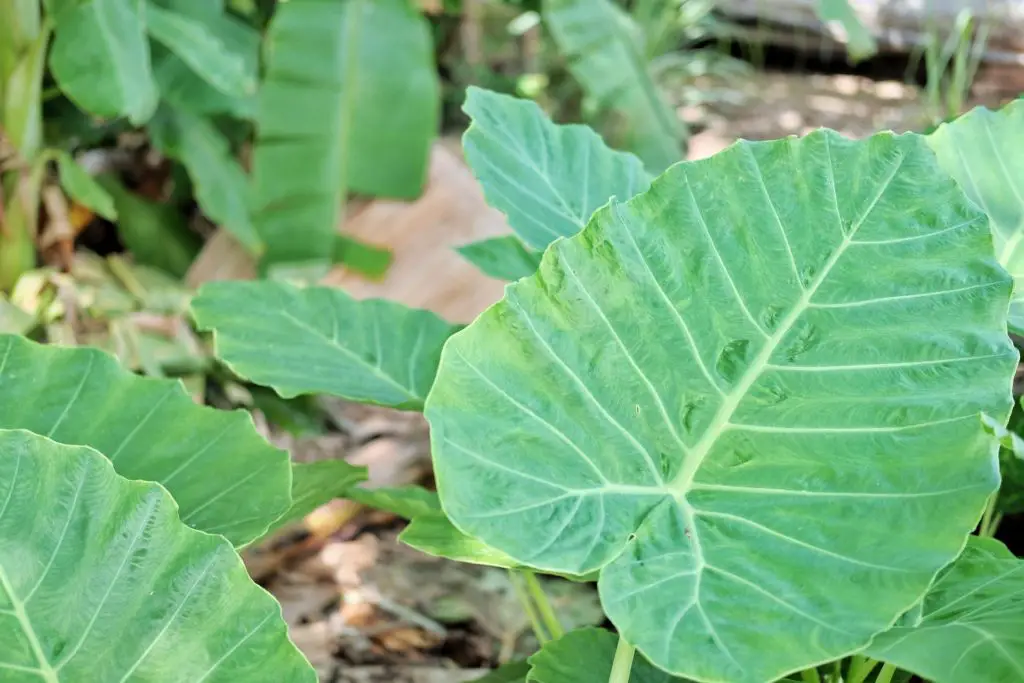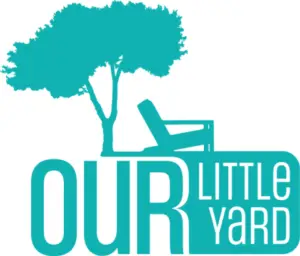As a lover of big green luscious leafed plants, we were looking for an alternative to hostas which are a favorite of the deer that frequent our yard. One day we will have big beautiful hostas and then the deer will wipe out entire plants in one evening. It’s become too much work to deter the deer, so we were determined to find an alternative that the deer would leave alone.
We actually found the elephant ear plants by chance while walking through Lowe’s one day. We saw the giant elephant ear bulbs and in bold letters on the tag it said that it was deer resistant. We have always wanted to try this plant out, so this was our sign to go for it.
Deer do not eat elephant ear plants and actually, this plant can be used as deer repellent. Deer will often change their path to avoid elephant ears so you may consider planting them near other plants that are popular with deer to help deter them.

This may be very surprising considering how much deer like leafy green plants, but there is a very interesting fact about elephant ear plants that make them resistant to deer. Elephant ear plants are actually toxic to humans and animals, especially in large quantities.
If you own hostas like we do, you know that deer can wipe out entire large plants in one evening, yet one bite of an elephant ear plant will create pain and discomfort for the deer and will likely discourage the deer from eating any more of the plant.
Are elephant ear plants poisonous?
Deer do not like elephant ear plants, but are they poisonous to people and pets? Pets and kids often touch and put things in their mouths that they are not supposed to, so when it comes to plants you should always be mindful of this. Elephant ear plants are, in fact, toxic to people, as well as dogs and cats. In fact, you should be careful when touching the leaves and stems as it can be irritating to the skin and even cause a rash.
Ingesting the leaves, stem, or sap of the elephant ear plant can cause a burning sensation and swelling of the mouth and throat. In dogs or cats that ingest part of the plant, you might see a number of symptoms including excessive drooling, swelling, trouble swallowing or breathing, diarrhea, or vomiting. It is important to seek medical help for children, adults, or pets who have ingested part of an elephant ear plant to determine if they need to be seen by a doctor or vet.
Check out our article: Is elephant ear sap poisonous?
What make elephant ear plants toxic?
Elephant ear plants contain something called insoluble calcium oxalate crystals, which is the same toxin found in rhubarb. Calcium oxalate is not broken down by the body metabolically but can cause irritation upon contact. The crystals are actually very sharp and are found in the leaves, stem, and sap of the plant. When an animal chews on the leave, they will experience pain on contact due to the crystals.
Symptoms of insoluble oxalate poisoning (from elephant ear plants)
There are several signs and symptoms that are typical of a human or animal that is suffering from insoluble oxalate poisoning. It is important to be aware of these symptoms if you have elephant ear plants in your yard or landscaping.
Here is a list of the most common symptoms:
- Vomiting
- Oral pain or swelling
- Diarrhea
- Rash
- Trouble swallowing
- Trouble breathing
- Excessive drooling (in animals)
What animals eat elephant ear plants?
The good thing about elephant ear plants is that you will likely not catch any wildlife eating your plant as they will experience irritation soon after taking their first bite. They are a great choice if you live in a wooded location or another area that has abundant wildlife that feed on your landscaping. Of course, you should consider whether you have pets, children, or livestock that will try to eat your elephant ear plants as they will likely become very sick.
If you see any type of holes in your elephant ear plants, it is likely smaller pests like beetles, caterpillars, or small insects like aphids, mealybugs, or mites. If this occurs you will need to wash off the leaves to get rid of the insects and apply a repellent to keep them away.
Where is the best place to plant elephant ears?
Typically elephant ear plants will grow in sun or shade with rich soil and regular watering. It is ideal if they get at least a few hours of shade each day. Depending on what growing zone you are in, elephant ear plants can grow year round. However, if you are in a zone that has cold winters with frost, then your plant will die out in the winter months.
If you are in an area with a cold winter, you will need to dig up the bulb and bring it inside if you plan to replant the following spring. If you leave the bulb in the ground during the winter, it will most likely not grow back the next year.
You should also consider planting in areas where you want to try and deter deer from eating other plants. We have had success planting our elephant ears near nandinas, hydrangeas, and hosta that we want the deer to stay away from. However, if you have pets or children, remember that this plant is toxic to them if they ingest it and can even cause skin irritation if they simply touch the leaves or stems.
Certain varieties of elephant ear plants can grow to 6 feet tall and the leaves can be up to an impressive 3 feet long. Their size makes these plants a great alternative to other leafy green plants that get devoured by deer that frequent your garden looking for their next meal. Elephant ear plants provide that beautiful green foliage, yet are resistant to most wildlife that destroys beautiful landscaping.
